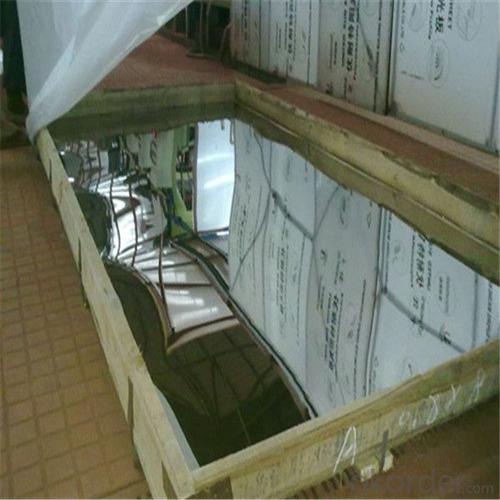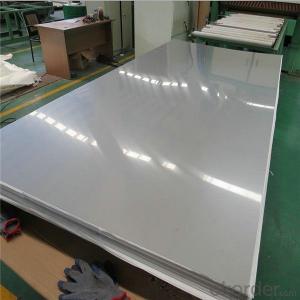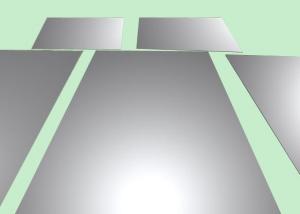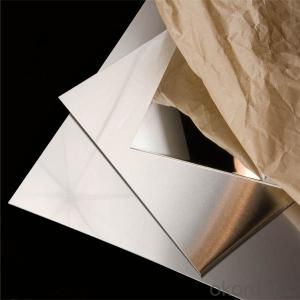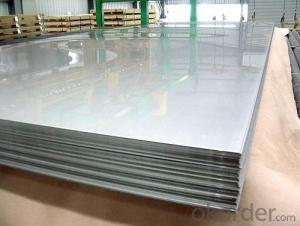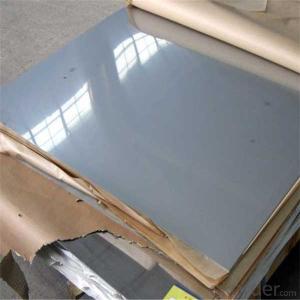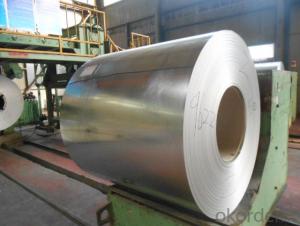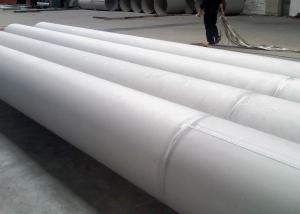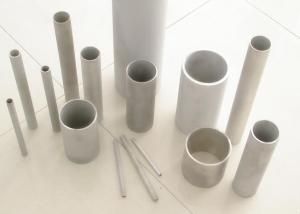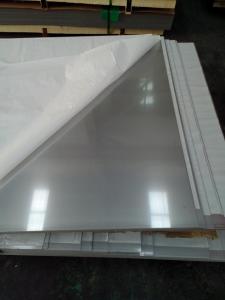Stainless Steel Sheets and Coils 310S 304
- Loading Port:
- Shanghai
- Payment Terms:
- TT OR LC
- Min Order Qty:
- 3 m.t.
- Supply Capability:
- 20000 m.t./month
OKorder Service Pledge
OKorder Financial Service
You Might Also Like
Specification
AISI ASTM 310S 2B Surface Stainless Steel Metal Plate/Sheet
| Products : | 310S 2B Surface stainless steel plate/sheet |
| Grade: | 201/202/304/304L/316/316L/321/317L/904L/430/S32205/309S/310S and so on |
| Stainless steel production type: | Cold rolled or Hot rolled stainless steel / Plate, Stainless steel flange, Stainless steel angle , Stainless steel pipe , Stainless steel flate , Stainless steel bar and so on |
| Thickness: | 0.35mm-12mm |
| Standard Size: | 4*8ft(1219*2438mm) , 4*10ft(1219*3048mm) , 1000*2000mm , 1500*3000mm or customize size |
| Brand: | TISCO BAOSTEEL JISCO POSCO Outokumpu ThyssenKrupp NSSC JFE NAS |
| Surface Type: | No.1 , 2B(No.2B) , NO.3 , No.4 , HL , BA(No.6) , Mirror(No.8) |
| Material Standard: | ASTM/JIS/GB |
| Surface Protection: | Paper or PVC |
| Application: | Chemical equipments & Pressure vessels & Machinery & Elevator |
Main product chemical composition
Grade | C % | Si % | Mn % | P % | S % | Cr % | Mo % | Ni % | Other % |
201 | ≤0.15 | ≤1.00 | 5.5-7.5 | ≤0.06 | ≤0.03 | 16-18 | - | 3.5-5.5 | N≤0.25 |
202 | ≤0.15 | ≤1.00 | 7.5-10.0 | ≤0.06 | ≤0.03 | 17-19 | - | 4.0-6.0 | N≤0.25 |
301 | ≤0.15 | ≤1.00 | ≤2.00 | ≤0.045 | ≤0.03 | 16-18 | - | 6.0-8.0 | - |
302 | ≤0.15 | ≤1.00 | ≤2.00 | ≤0.045 | ≤0.03 | 17-19 | - | 8-10.0 | - |
303 | ≤0.15 | ≤1.00 | ≤2.00 | ≤0.2 | ≥0.015 | 17-19 | ≤0.6 | 8.0-10.0 | - |
304 | ≤0.08 | ≤1.00 | ≤2.00 | ≤0.045 | ≤0.03 | 18-20 | - | 8-10.5 | - |
304L | ≤0.03 | ≤1.00 | ≤2.00 | ≤0.045 | ≤0.03 | 18-20 | - | 9-13 | - |
309S | ≤0.08 | ≤1.00 | ≤2.00 | ≤0.045 | ≤0.03 | 22-24 | - | 12-15 | - |
310S | ≤0.08 | ≤1.5 | ≤2.00 | ≤0.045 | ≤0.03 | 24-26 | - | 19-22 | - |
316 | ≤0.08 | ≤1.00 | ≤2.00 | ≤0.045 | ≤0.03 | 16-18 | 2-3 | 10-14 | - |
316L | ≤0.03 | ≤1.00 | ≤2.00 | ≤0.045 | ≤0.03 | 16-18 | 2-3 | 12-15 | - |
317 | ≤0.08 | ≤1.00 | ≤2.00 | ≤0.045 | ≤0.03 | 18-20 | 3-4 | 11-15 | - |
321 | ≤0.08 | ≤1.00 | ≤2.00 | ≤0.045 | ≤0.03 | 17-19 | - | 9-13 | Ti≥5×C |
430 | ≤0.12 | ≤0.75 | ≤1.00 | ≤0.04 | ≤0.03 | 16-18 | - | ≤0.6 |

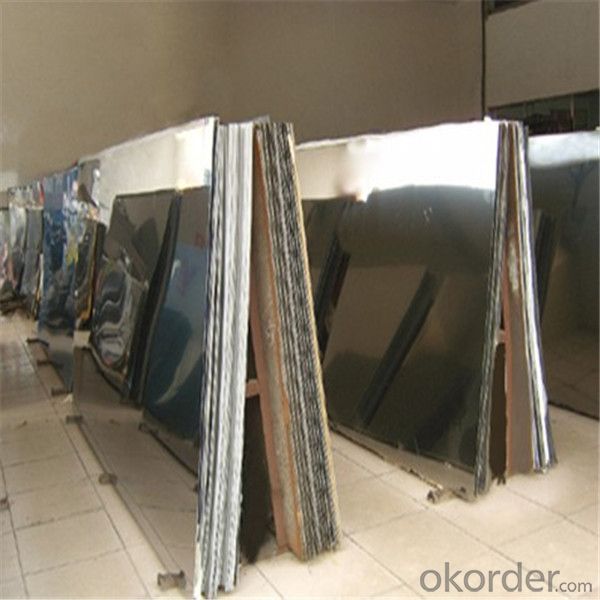
- Q: What is the difference between brushed and polished stainless steel sheets?
- The appearance and texture of brushed and polished stainless steel sheets vary. Brushed sheets have a matte finish achieved by brushing the surface with an abrasive material, which creates parallel lines or patterns. This finish helps conceal scratches and fingerprints, making it popular for durable applications. On the other hand, polished sheets have a glossy finish achieved by polishing with a fine abrasive compound. This process eliminates imperfections and scratches, resulting in a mirror-like reflection. The polished finish is more visually appealing and commonly used for decorative purposes. In summary, the main distinction between brushed and polished stainless steel sheets lies in their appearance and texture. Brushed sheets have a textured, matte finish that is more resistant to scratches and fingerprints, while polished sheets have a smooth, glossy finish that provides a mirror-like reflection. The choice depends on the desired aesthetic and specific application requirements.
- Q: Can stainless steel sheets be used in automotive industry?
- The automotive industry finds stainless steel sheets to be a valuable resource. This material has gained popularity due to its numerous advantageous properties. Its exceptional resistance to corrosion makes it an ideal choice for components that are exposed to harsh weather conditions, like car exteriors and body panels. Stainless steel sheets are also renowned for their impressive strength-to-weight ratio, enabling the creation of lightweight yet sturdy automobile parts. Moreover, stainless steel exhibits remarkable heat resistance and can endure high temperatures, making it suitable for applications like exhaust systems. In summary, stainless steel sheets are extensively utilized in the automotive industry because of their durability, ability to resist corrosion, and versatility in various applications.
- Q: How do you straighten bent stainless steel sheets?
- Depending on the severity of the bend, there are several methods available for straightening bent stainless steel sheets. 1. For slight bends, a rubber mallet or hammer can be used to gently tap the bent area back into place. Gradually apply even pressure, starting from the center of the bend and moving towards the edges. It is important to avoid striking the stainless steel too forcefully, as this could cause further damage. 2. In cases of more severe bends, heat can be used to soften the stainless steel, making it easier to straighten. Begin by heating the bent area using a blow torch or heat gun. Once the stainless steel reaches a red-hot temperature, carefully use pliers or a vice grip to straighten the sheet. It is important to note that this method is most suitable for thicker stainless steel sheets, as thinner ones may warp or lose their shape when exposed to excessive heat. 3. For larger or heavy-duty sheets that cannot be easily straightened by hand, mechanical straightening is recommended. This involves using specialized tools like a hydraulic press or metal brake to apply controlled pressure and straighten the bent stainless steel sheet. It is crucial to carefully follow the manufacturer's instructions when using these tools to prevent accidents. Always wear appropriate safety gear, such as gloves and eye protection, when working with stainless steel sheets. If you are unsure or uncomfortable with straightening the sheets yourself, it is advisable to seek assistance from a professional metalworker or fabrication shop.
- Q: Are stainless steel sheets suitable for water treatment applications?
- Yes, stainless steel sheets are highly suitable for water treatment applications. Stainless steel is known for its excellent corrosion resistance, making it the ideal choice for environments where water and moisture are present. It is resistant to rust, staining, and pitting, which ensures the longevity and durability of the sheets in water treatment facilities. Stainless steel sheets also offer hygienic properties, as they are easy to clean and maintain. This is crucial in water treatment applications where cleanliness and sanitation are of utmost importance. Additionally, stainless steel is non-reactive with water, meaning it does not leach harmful substances into the water being treated. Furthermore, stainless steel sheets are strong and can withstand high pressures and temperatures. This is critical in water treatment processes that involve filtration, disinfection, and other treatment methods that may require intense conditions. Overall, stainless steel sheets are an excellent choice for water treatment applications due to their corrosion resistance, hygienic properties, strength, and durability. They provide a reliable and long-lasting solution for various components in water treatment facilities, including tanks, pipes, valves, and other equipment.
- Q: Are stainless steel sheets suitable for architectural handrails or guardrails?
- Yes, stainless steel sheets are highly suitable for architectural handrails or guardrails. Stainless steel is known for its durability, corrosion resistance, and aesthetic appeal, making it an ideal material for such applications. Its strength and long-lasting properties ensure the handrails or guardrails can withstand heavy usage and harsh weather conditions while maintaining a sleek and modern appearance.
- Q: How do you cut stainless steel sheets?
- Cutting stainless steel sheets can be done using different methods, depending on the thickness of the sheet and the desired precision of the cut. Here are a few common techniques: 1. Manual cutting: For thinner stainless steel sheets (up to around 16 gauge), you can use a handheld shear or tin snips. These tools allow you to cut straight lines or curves by applying pressure and cutting through the sheet. However, this method may not be suitable for thicker sheets as it can be labor-intensive and produce rough edges. 2. Power shears: For thicker stainless steel sheets, power shears or electric nibblers are more effective. These tools use a sharp cutting blade or punch to make straight or curved cuts. They provide more precision and require less effort compared to manual cutting methods. 3. Circular saw: A circular saw with a carbide-tipped blade designed for cutting metal can also be used to cut stainless steel sheets. This method is suitable for thicker sheets and allows for straight cuts. However, it may produce more noise, sparks, and heat, so proper safety measures such as wearing protective goggles and gloves should be taken. 4. Plasma cutting: For industrial or heavy-duty applications, plasma cutting is commonly used. This method involves using a high-temperature plasma jet to melt through the stainless steel sheet, creating a precise and clean cut. Plasma cutting machines are expensive and require specialized training to operate. Regardless of the method, it is important to take safety precautions when cutting stainless steel sheets. Always wear protective gear, such as safety glasses, gloves, and a dust mask, to protect yourself from metal shards, sparks, and dust. Additionally, ensure that the sheet is securely clamped or supported to prevent it from moving during the cutting process.
- Q: What are the different types of brushed finishes available for stainless steel sheets?
- Stainless steel sheets offer a variety of brushed finishes, each with its own distinct appearance and texture. Some of the most commonly used finishes are as follows: 1. The #4 Brushed Finish: This is the go-to choice for many as it provides a smooth, directional grain achieved through the use of a grit belt or wheel. People often refer to this finish as a satin finish. 2. The #6 Brushed Finish: For a more refined appearance, the #6 finish is the way to go. It is achieved by using a higher grit abrasive belt or wheel, resulting in a smoother and more sophisticated look. This finish is often chosen for decorative purposes or when a higher level of elegance is desired. 3. The #8 Mirror Finish: If you're after a glossy, reflective appearance, the #8 finish is the perfect choice. It requires extensive polishing and buffing to achieve a nearly perfect reflective surface. This finish is highly favored in architectural and decorative applications where a polished and glamorous look is desired. 4. The Bead Blasted Finish: To achieve a matte, non-reflective surface, stainless steel sheets are blasted with glass beads under high pressure. This process creates a uniform and textured appearance, making it ideal for applications that require a low-maintenance finish. 5. The Linen Finish: For a visually appealing touch, the linen finish offers a pattern of parallel lines that resemble linen fabric. This finish is achieved by using abrasive belts or wheels with varying grit sizes, resulting in a textured finish. It is commonly used in architectural and interior design applications. These examples represent just a few of the many brushed finishes available for stainless steel sheets. The choice of finish will depend on the desired aesthetic, functionality, and specific application requirements.
- Q: Can stainless steel sheets be used for water filtration?
- Yes, stainless steel sheets can be used for water filtration. Stainless steel is known for its corrosion resistance, durability, and ability to withstand high temperatures, making it a suitable material for water filtration applications. Stainless steel sheets can be formed into various filter elements such as screens, mesh, or cartridges, which efficiently remove impurities and contaminants from water. The fine mesh size of stainless steel sheets allows for effective filtration while maintaining a high flow rate. Additionally, stainless steel is non-reactive and does not release harmful substances into the filtered water, ensuring its safety for consumption. Overall, stainless steel sheets are a reliable choice for water filtration due to their excellent mechanical properties and resistance to corrosion.
- Q: Can stainless steel sheets be used for stadium seating?
- Yes, stainless steel sheets can be used for stadium seating. Stainless steel is a durable and corrosion-resistant material, making it suitable for outdoor applications like stadium seating. It can withstand the elements, including rain, snow, and UV rays, without deteriorating or rusting. Stainless steel sheets can be fabricated and formed into various seating structures, providing a sturdy and long-lasting seating solution for stadiums. Additionally, stainless steel has an aesthetic appeal and can be finished in different ways to enhance its visual appearance, further adding to the overall design of the stadium.
- Q: How do you prevent pitting corrosion on stainless steel sheets?
- To prevent pitting corrosion on stainless steel sheets, there are several measures that can be taken: 1. Proper alloy selection: Choosing the right grade of stainless steel with high resistance to corrosion is crucial. Grades such as 316 and 904L are known for their excellent resistance to pitting corrosion. 2. Passivation: Stainless steel sheets should be passivated after fabrication to remove any free iron or contaminants on the surface. Passivation involves treating the sheets with an acid solution, followed by a thorough rinse and drying. This helps to restore the protective chromium oxide layer on the surface, enhancing corrosion resistance. 3. Regular cleaning and maintenance: Stainless steel sheets should be cleaned regularly to remove any dirt, debris, or contaminants that can lead to pitting corrosion. Mild soap, water, and a soft cloth or sponge can be used for routine cleaning. Harsh or abrasive cleaners should be avoided. 4. Avoid exposure to aggressive environments: Stainless steel sheets should be protected from exposure to chemicals, chlorides, acids, and other corrosive substances. If such exposure is unavoidable, proper measures like the use of protective coatings or barriers should be implemented. 5. Avoid stagnant conditions: Pitting corrosion is often accelerated in stagnant or low-flow conditions where oxygen levels are depleted. Ensuring proper ventilation and circulation of air or fluids can help prevent pitting corrosion on stainless steel sheets. 6. Regular inspection and maintenance: Periodic visual inspection and monitoring of stainless steel sheets can help identify any early signs of pitting corrosion. If any pitting is noticed, immediate action should be taken to address the issue, such as applying a suitable corrosion inhibitor or protective coating. By following these preventive measures, it is possible to minimize the risk of pitting corrosion on stainless steel sheets, ensuring their long-term durability and performance.
Send your message to us
Stainless Steel Sheets and Coils 310S 304
- Loading Port:
- Shanghai
- Payment Terms:
- TT OR LC
- Min Order Qty:
- 3 m.t.
- Supply Capability:
- 20000 m.t./month
OKorder Service Pledge
OKorder Financial Service
Similar products
Hot products
Hot Searches
Related keywords


